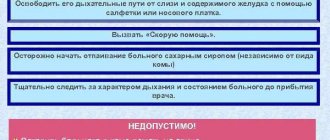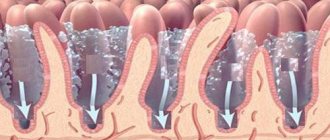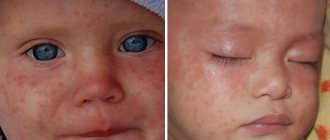Article verified by Euromed Kids doctors
There are many infectious diseases that affect the digestive system. Common symptoms of an intestinal infection:
- intoxication (fever, headache, weakness);
- stomach ache;
- nausea and vomiting;
- diarrhea.
In addition to these symptoms, some intestinal infections also have their own manifestations, for example, blood in the stool or a specific type of pain, which can be important for diagnosis.
Diagnosing intestinal infections is not always easy. We recommend contacting us to conduct a rapid test for intestinal infections to quickly and correctly select the method and place of treatment.
How does an intestinal infection occur?
Viruses, bacteria and protozoa that cause intestinal infections live in the stool, saliva, urine and vomit of patients. Then they can get into water, food, and various objects, and thus infect other people. Therefore, measures to prevent intestinal infections are to wash your hands, as well as fruits, vegetables and berries, maintain hygiene after using the toilet, do not drink from the same bottle with others, use only your own spoon and fork.
Do not consume unboiled milk; thoroughly boil or fry meat. An intestinal infection can be contracted by swimming in dirty water and in many other ways. Some intestinal infections, especially viral ones, are transmitted through household contact.
Treatment
Currently, specific treatment regimens for rotavirus infection have not been developed. With a mild course of the disease, the symptoms go away on their own. Patients are advised to diet and take medications to restore fermentation in the digestive system. Enterosorbents that mitigate the symptoms of diarrhea and vomiting can help cope with the symptoms of a viral infection. If the patient is dehydrated, rehydration therapy with the use or intravenous administration of saline solutions is indicated.
What organs are affected by intestinal infections?
Intestinal infections can be classified according to the organ that has been “attacked” by microbes:
- gastritis - inflammation of the gastric mucosa. It manifests itself as pain in the abdomen above the navel, constant nausea, and repeated vomiting. Diarrhea is not typical, but there may be loose stools 1-4 times. Acute infectious gastritis usually develops when infected with Staphylococcus aureus (food poisoning) or viruses.
- gastroenteritis - inflammation of the mucous membrane of the stomach and small intestine. It manifests itself as pain in the abdomen around the navel, vomiting, frequent stools, first mushy, then watery, with undigested food debris. Usually develops with viral intestinal infections or damage by pathogenic strains of Escherichia coli.
- enteritis - inflammation of the mucous membrane of the small intestine. It manifests itself as frequent watery stools without nausea, vomiting and abdominal pain. Enteritis can develop, for example, with cholera (but also in other cases).
- gastroenterocolitis - inflammation of the mucous membrane of the stomach, large and small intestines. It manifests itself as abdominal pain, pain during bowel movements, frequent loose stools, sometimes with blood and mucus. Characteristic for salmonellosis.
- enterocolitis - inflammation of the intestinal mucosa (small and large). It manifests itself as severe abdominal pain, frequent urge to have bowel movements, loose stools (sometimes in the end only mucus is released). Characteristic of salmonellosis and dysentery.
- colitis - inflammation of the large intestine. It manifests itself as pain in the lower abdomen, diarrhea, sometimes with blood and mucus. Characteristic of dysentery.
Varieties
For developmental reasons, intestinal infections in children are classified into the following types:
- salmonellosis;
- dysentery;
- Escherichiosis;
- yersiniosis;
- rotavirus infection;
- campylobacteriosis;
- staphylococcal intestinal infection.
There are also acute, protracted and chronic phases of intestinal infections. The duration of the acute phase is no more than 1.5 months. The protracted phase lasts more than 1.5 months, and the chronic course of the infectious process drags on for a period of up to six months.
Viral intestinal infections
Rotavirus infection
Children most often suffer from rotavirus infection. As a rule, adults have developed immunity, because almost everyone suffered from rotavirus in childhood.
Symptoms of rotavirus:
- temperature rise to 38-39;
- cramping abdominal pain;
- weakness, loss of appetite;
- repeated vomiting;
- diarrhea up to 10-15 times a day, stools are liquid, foamy, brown-yellow, after 1-2 days - clayey, yellowish-gray;
- sometimes - sore throat, runny nose, conjunctivitis.
There is a Rotatek vaccine against rotavirus. While it is not included in the Russian calendar, it can be done for a fee. We advise you to vaccinate your child, as rotavirus can be very dangerous for children under two years of age, quickly causing dehydration and causing serious complications.
Adenovirus infection
Adenoviral enteritis is commonly called “intestinal flu.” This virus affects the small intestine, stomach, large intestine - all at once. Children get sick more often, but adults too. In addition to the usual route of transmission of intestinal infections, adenovirus can be contracted through airborne droplets through contact with a patient.
Symptoms of adenoviral enteritis:
- abdominal pain;
- moderate nausea and vomiting;
- loose stools several times a day, often with a greenish tint;
- rumbling in the stomach;
- temperature rise to 38 and above (can persist for 3-5 days);
- pallor, dry tongue.
Adenovirus in young children and the elderly is fraught with complications, especially dehydration.
Enterovirus infection (Coxsackie viruses A and B, ECHO viruses)
Enteroviruses are a common name for more than 100 types of viruses that reproduce in the gastrointestinal tract. Almost all of them are pathogenic and dangerous because they can live outside the body for a long time and are extremely difficult to destroy. Thus, enteroviruses can live in moist soil and enter the body through poorly washed vegetables; even in chlorinated water, enteroviruses remain viable for 3-4 months. It is not surprising that enteroviral intestinal infections are very common. Children endure them more severely than adults.
Most often, enterovirus infections begin acutely, with an increase in temperature, which can then either rise or normalize. Diarrhea, nausea, vomiting, weakness, lack of appetite and headache also occur. At the same time, symptoms characteristic of ARVI may appear - itching and sore throat, runny nose and cough.
Enterovirus infection can cause relapses: symptoms subside and then develop with renewed vigor.
Questions and answers
How is rotavirus infection transmitted?
The mechanism of transmission of the virus is fecal-oral, where the causative agent of the disease enters the environment along with the feces of the carrier or patient, and then on dirty hands into the body of a healthy person. Household items, food, dirty water - all this can become a source of infection.
What can you eat if you have rotavirus infection?
Recommendations for a patient with rotavirus infection include dietary table No. 46 with restrictions on the amount of carbohydrates and dairy dishes, as well as an increase in the amount of protein foods. This diet plan is aimed at restoring the body’s immune system and stabilizing the digestive system that has been hit by the virus.
How long does rotavirus infection last?
The duration of the disease depends on the state of health of the person and his immune system. It may take 10-15 days from the moment of infection to complete recovery, where the first 6-7 days are an acute period with a whole bunch of unpleasant symptoms. The incubation period lasts from several hours to five days, after which the infection immediately makes itself felt with a sharp deterioration in the patient’s condition.
Bacterial intestinal infections
Botulism
Botulism is a rare but dangerous intestinal infection, as it affects the nervous system, leads to extremely serious consequences and is difficult to diagnose. Botulism can be contracted from eating home-canned food (no outbreaks associated with factory-made canned food have been reported in recent decades), or less commonly through contact with someone who is sick (usually infants).
Botulism begins with short-term nausea and vomiting, then a feeling of fullness in the abdomen occurs - a consequence of paresis (partial paralysis) of the intestines and stomach. Then muscle weakness, dry mouth, and visual disturbances (fog before the eyes) appear. By the end of the first day of illness, respiratory failure may develop. Mortality without treatment is 30-60%. With a timely diagnosis (this can be difficult due to the fact that this infection is rare, and the manifestations are easily confused with many other diseases), the victims are given an toxoid, and, as a rule, a gradual recovery occurs within 2-3 weeks.
Dysentery (shigellosis)
Dysentery is a common disease caused by Shigella bacteria. Amoebic dysentery, caused by protozoa, also occurs. People of all ages are susceptible to dysentery, but 60% of patients are children under 4 years of age.
Dysentery begins acutely with abdominal pain and stool upset (10-20 times a day). By the end of the first day, “spit-shaped stool” consisting of pus, mucus and blood is characteristic. On days 2-3, the manifestations of dysentery are maximum. The temperature can reach 39, and in severe forms, rise even higher. The patient is pale, the tongue is covered with a brown coating. A characteristic sign of dysentery is sharp pain when palpating the left iliac region. With severe dysentery, serious complications can develop, including peritonitis. Dysentery is extremely dangerous for young children and must be treated in a hospital. The temperature in moderate forms of dysentery usually decreases on the 4-5th day of illness, but complete recovery occurs only after 2-3 weeks.
Bacterial intestinal infections also include salmonellosis, staphylococcal food poisoning and cholera. It is extremely important to distinguish dysentery from food poisoning, and if treatment is necessary, to make it easier for the doctor to quickly and correctly choose an antibiotic.
In our clinic you can undergo express diagnostics in just 1 hour to identify 4 viruses that most often cause intestinal infections! Click to find out more.
Diagnostics
A preliminary clinical diagnosis is made based on the child’s complaints and visual examination. As a rule, consultation with a pediatrician and an infectious disease specialist is necessary. To confirm the clinical diagnosis, the following examination methods are prescribed:
- bacteriological analysis of stool, which should be carried out before treatment;
- blood culture for sterility;
- if necessary, bacteriological analysis of cerebrospinal fluid and urine is performed;
- serological research methods (ELISA, RPGA, RSK);
- coprogram.
When characteristic symptoms appear, differential diagnosis is performed with pathologies such as lactase deficiency, pancreatitis, acute appendicitis, and biliary dyskinesia.
How can you tell if dehydration is developing?
Intestinal infections lead to the body losing water and salts (sodium, potassium, chlorine, etc.) due to vomiting and diarrhea. Dehydration is one of the main dangers of an intestinal infection, as it can very quickly lead to death, especially in young children. A parent should be wary if he sees the following signs:
- dry mucous membranes of the mouth and tongue;
- grayish skin;
- saliva viscosity increased;
- the child is lethargic, sleepy;
- the baby’s fontanelle on the head sinks, the pulse quickens;
- the baby peed twice or less in 12 hours, the amount of urine is small, it may be dark, with a strong odor;
- intense vomiting, the child cannot be given anything to drink. In this case, you should go to the hospital, where the child will be given a drip and the fluid balance in the body will be restored.
general information
The group of intestinal infections characteristic of childhood includes diseases of a bacterial and viral nature, accompanied by signs of general intoxication of the body and dehydration. In terms of frequency of occurrence, intestinal infections are in 2nd place after ARVI and influenza. The adult body is less susceptible to infectious pathogens that cause digestive disorders. Intestinal infections are most severe in infants. In this case, not only dehydration is observed, but also symptoms such as dysbiosis, a sharp decrease in body weight, deficiency of pancreatic enzymes and decreased immune defense.
How to feed a child with an intestinal infection?
If you are being treated at home and your child is vomiting and has diarrhea, the most important thing is to give your child the right amount of water. Often, if a sick child drinks several sips at once, this can trigger vomiting and he will lose even more fluid. Therefore , it is recommended to feed the child every 5-10 minutes, giving him 5-15 ml of liquid at a time. You should not give your child only clean water, as this can lead to a salt imbalance.
You can give your child a pharmaceutical rehydrate solution (for example, Regidron) or prepare such a solution yourself. However, if the child does not drink at all, the choice should be made in favor of any liquid that he agrees to swallow.
Clostridiosis
Severe clostridiosis can occur in three clinical variants: 1. with the manifestation of severe toxicosis and anaerobic sepsis; 2. cholera-like form; 3. with the development of necrotic enteritis, sometimes complicated by intestinal perforation and peritonitis.
Intestinal infections caused by Escherichia and rotasirus occur with secretory diarrhea syndrome. Secretory diarrhea has its own clinical features that allow it to be differentiated from other diseases of the gastrointestinal tract.
Etiology of acute intestinal infections
The etiology of intestinal infections is associated with the entry of the pathogen into the body. There are 3 main routes through which they enter the body:
- through food - usually through food products that have not undergone sufficient hygienic and heat treatment;
- through water - symptoms and etiology of intestinal diseases when infected through water occur when drinking low-quality water;
- during everyday contact - through various objects or dirty hands.
Bacterial acute intestinal infections are often caused by bacteria such as salmonella, E. coli, and viral ones - by the entry into the body of rotaviruses, enteroviruses, etc. Severe clinical symptoms occur with amoebiasis and giardiasis, which are relatively rare causes.
Escherichiosis caused by EPC
Most diseases are caused by 4 serotypes: O18, O111, O55, O26. Mostly infants who are bottle-fed are affected.
Seasonality: winter-spring. Routes of infection: household contact (often hospital-acquired) and food. An endogenous pathway for the development of diarrhea is possible, as evidenced by the frequency of carriage of Escherichia in healthy individuals and the frequent appearance of pathological stools during intercurrent diseases, for example, acute respiratory diseases (ARI). Depending on the route of infection and the age of the children, the disease can occur in three clinical variants.
The first is the “cholera-like variant” of the course of the disease, which is most typical for children in the first year of life. The disease has a gradual onset with the appearance of symptoms: vomiting, diarrhea and the addition of other symptoms of the disease in the next 3-5 days.
The body temperature in most patients is normal or subfebrile, hyperthermia is almost not observed. Vomiting (regurgitation) is the most constant symptom, which appears from the first day of illness and is persistent and long-lasting. The stool is watery, spattering, yellow-orange in color, with a moderate amount of mucus mixed with feces. Its frequency increases and reaches a maximum on the 5-7th day of illness. Cramping abdominal pain is rarely observed.
In terms of the frequency of severe forms of the disease in infants, escherichiosis of the enteropathogenic group ranks third after yersiniosis and salmonellosis (S. thyphimurium). The most severe diseases are those caused by EPEC O55 and O111. The severity of the condition in patients is not due to symptoms of intoxication, but to severe disturbances of water-mineral metabolism and the development of echsicosis of II and III degrees. In some cases, hypovolemic shock is observed; decreased body temperature, cold extremities, acrocyanosis, toxic shortness of breath, darkened consciousness, tachycardia, changes in acid-base state (ABS). The mucous membranes are dry and bright, the skin fold does not straighten out, the large fontanelle sinks. Oligoanuria may develop. Thus, the “cholera-like” form of EPE in young children has specific symptoms and in most cases does not present difficulties in differential diagnosis: gradual onset, watery diarrhea, persistent infrequent vomiting, moderate fever, exicosis in the absence of pronounced symptoms of intoxication.
The second variant of the course of escherichiosis of the EPE group, which occurs in 30% of patients, is mild enteritis that occurs against the background of acute respiratory infections in young children. In this case, one can think about secondary endogenous infection with Escherichia when the body’s immunoreactivity is weakened due to the underlying disease.
The third clinical variant of the disease is foodborne toxic infection (PTI). Its development is caused by the food route of infection, which is typical for children over 1 year of age. This syndrome is characterized by vomiting and watery diarrhea. However, there are also differences from toxic infections of other etiologies (dysenteric, salmonellosis, staphylococcal): 1. in most children, a subacute and gradual onset with the development of all symptoms by the 3-4th day of the disease; 2. predominantly mild course of the disease; 3. absence of symptoms of intoxication, the severity of the disease is determined by the phenomena of exicosis.
Escherichiosis caused by ETC
Despite the diversity of pathogens in this group, most diseases are caused by five of them: O8, O6, O9, O75 and O20. Escherichiosis of this group is widespread among children of all age groups and is the etiological factor of every third laboratory-deciphered gastroenteritis or enteritis. This group of diseases is characterized by a predominantly summer seasonality (July-August).
However, in the clinical course of the disease there is a great similarity with escherichiosis caused by EPKP. In children of the 1st year of life, diseases of the ETE group occur in the form of “cholera-like” diarrhea, and in children over 1 year of age - of the PTI type, which is associated with the action of a “cholera-like” heat-labile enterotoxin, which is found with equal frequency in both groups of Escherichia .








